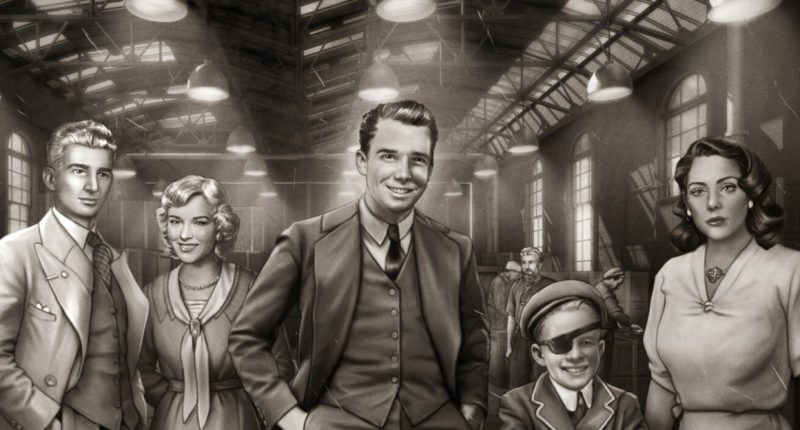Share this @internewscast.com
While healing from a broken arm, Robin Ward discovered a passion for an indie browser game titled The Roottrees are Dead on the itch.io platform. He contacted its creator, Jeremy Johnston, expressing that it deserved more recognition. However, Ward understood why it remained relatively obscure.
The game utilized AI-generated images, integral to the players’ experience of solving intricate puzzles by piecing together a complex family hierarchy. At that time, Steam, the leading distributor of PC games, prohibited games using generative AI from being sold on their platform. Additionally, both Ward and Johnston agreed it would be “unethical to sell artwork produced in this manner.”
Despite dedicating 11 months to developing the game from a project initiated at the Global Game Jam in 2023, Johnston decided to offer it at no charge. The initial version was rapidly assembled in less than a week. Before generative AI gained widespread attention, Johnston consulted a friend skilled in Midjourney to create images following his puzzle prompts. This collaboration enabled him to bring his vision to life during the condensed timeframe of the game jam.


The images were far from perfect. Both Johnston and Ward point out a warped, staring image of a young girl in the original version of the game (which is still available for free) — Ward calls it “demonic.” Other portraits have the twisted hands that were a telltale giveaway of generative AI at the time.
But despite expanding the game for almost a year, adding to the story and puzzle aspects, Johnston says he “never really thought” to replace the art. Not being an artist himself, he was focused on the photographic quality of the existing artwork, and he knew he would never be able to afford to hire models and a cameraperson to recreate it.
And although he was putting a lot of work into the expanded version, he wasn’t expecting the reaction it would eventually get. “I’ve released other things — not games, necessarily, but things that I spent a lot of time and energy on, and then they came out and no one cared,” he says. So although he spent a lot of time on Roottrees, he did not want to invest money he was never expecting to get back.


When he did release the itch.io version of Roottrees, though, it was surprisingly popular. It spread on forums and Reddit, and it received some attention in the games press. He did not charge for it, on account of the AI artwork, although he did include a donation link and says he made around $2,000-$3,000 from more than 10,000 players.
And one of those players was Ward. After reaching out to Johnston, they agreed that Ward would reprogram the game and hire an illustrator to replace the AI artwork and get it ready for a Steam release. The illustrator he brought on, Henning Ludvigsen, says he used the AI art as a kind of concept sketch. Ludvigsen then did his own research into the era and style the picture was supposed to evoke, eventually making almost 40 illustrations across nearly a year of work.
“I’m not a big fan of generative AI,” he says, saying his peers in the illustration industry have seen a reduction in work, particularly concept artists. “[Companies] kind of skip that step now [using AI], which I think is not great.”


When it comes to finished products, though, he still sees generative AI as “not doing that well in general” among players. Large video game companies like Take Two Interactive have noted that players tend to not only avoid games that use AI but also react negatively to them online and in ratings, calling it a potential avenue for “loss of players, revenues…and reputation harm.” Johnston mentions the case of Cyan Worlds, the developer behind Myst, receiving backlash for using “AI assisted content” like texture assets in its latest game.
The Roottrees are Dead seemed to skirt these issues by being transparent about its use upfront, as well as releasing for free, Johnston says. Ward also points out that “in this case, it’s the case of ‘there would be no game’ versus ‘there is a game.’” Johnston agrees that without the use of AI-generated artwork, the initial version would never have been released, meaning the eventual full version with Ludvigsen’s work in it would also never have existed. Ludvigsen himself says he “really enjoyed” replacing the illustrations, given he’s “not a big fan of” AI art generation in general.
“I think some people would say, ‘Well, I would prefer that there is no game in this case,’ and I think they’re entitled to their opinion,” Ward says, citing the environmental concerns and the scrapping of artists’ work for training corpuses as potential arguments for that approach. “But I ended up playing something that I really loved,” he says.


The game was released on Steam in January 2025. “The vast majority of people are like, ‘I’m very happy you got rid of the AI,’” Ward says. Although some have said they prefer the more photographic quality of the generated art, Ludvigsen’s work is undeniably an upgrade, from the untwisted fingers to the increased consistency in design for characters who appear in multiple photographs, which makes some puzzles more understandable.
The Roottrees are Dead is now a critical and commercial success, which would not have happened without both generative AI and a human artist. Both Ward and Johnston note that the game took an unusual route to its current state. But with the increasing prevalence of AI tools, it’s possible more games will end up on the same path.








